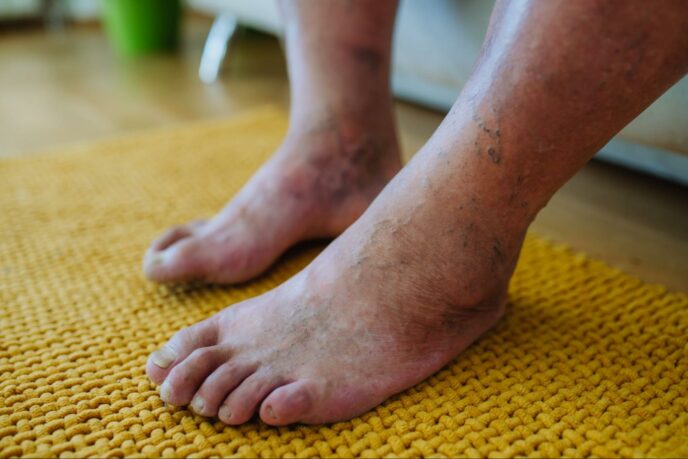
Warning Signs of PAD
Generally, people with peripheral artery disease (PAD) have mild or no symptoms, but there are warning signs that patients should be aware of. In this article, Dr. Chirs Donikyan discusses the warning signs and symptoms of PAD to look out for and which diseases are more prone to lead to the development of peripheral artery disease.
What are the Warning Signs of PAD?
Simple things to look for are skin changes, changes in the color of your skin, wounds that you developed that might become difficult to heal, cramping when you walk, discomfort. If all of a sudden, when you had been able to walk five blocks and now you can only walk four or three without developing cramps in your buttock region or your calves or your thighs, those are signs that you might not be getting enough blood flow down to the muscles in your legs when you’re walking.
You can also develop pain when you’re resting. That’s a more serious sign. If you’re sitting on the couch or not exerting yourself but you’re having pain, that’s a sign that there’s an issue with blood getting down to your feet or your lower extremities.
So all those things, the skin changes, difficulty walking, cramping, and rest pain, are major indications that something’s not quite right in terms of the amount of blood flow that’s getting to your feet.
Does smoking increase the risk of PAD?
Yes, smoking increases the risk of PAD and for former smokers as well. Smoking in and of itself is a problem. You’re developing plaque, that plaque is still going to be there even if you stop smoking.
However, stopping smoking is important. If you do have those plaques, unfortunately, plaque can propagate and you can develop a clot that can cause occlusion in one of your arteries. There is a baseline plaque that’s formed as a former smoker. But certainly, we advocate that people stop smoking to reduce further plaque buildup.
Stopping smoking is a big part of what we do at American Endovascular. If we have to intervene and do ballooning and stenting, and patients continue to smoke, the likelihood of the work that we have done not maintaining a result is a problem.
What Diseases Can Cause PAD?
Each individual problem, like diabetes or kidney disease, is by itself a big problem in terms of developing peripheral artery disease. When you have patients that have diabetes, chronic kidney disease, and heart disease or additional diseases, such as coronary artery disease, it compounds the issue and multiplies the risks for PAD tenfold. A lot of times these patients, specifically patients with diabetes, tend to have renal failure and a lot of other comorbidities.
Just like with heart disease, PAD can creep up on you. In some cases, you don’t find out about it until it’s too late or until there are major blockages. It can become very difficult to manage, taking large risks in terms of re-vascularization. A lot of times these patients, patients with diabetes, tend to have renal failure and a lot of other comorbidities.
The best thing to do is to get a screening so that we can be proactive instead of reactive. We start to get baseline ideas of what the vascularity is to limbs. Similar to getting a stress test in a cardiologist’s office, we evaluate the blood flow to your limbs and make sure that if something is developing, we can measure how it progresses and react to it.
How Common is PAD with People that Have Diabetes?
It’s very common. Patients with diabetes tend to have peripheral artery disease. Being a radiologist, I frequently read X-rays on patients that have diabetes. You can see calcification and plaque on X-rays that have developed in all of their blood vessels.
The problem is they tend to form those plaques more distally, down the line in the toes, deep in the foot. That’s why you get those amputation type settings where the plaques develop in the tiniest arteries of the hands and feet or even in the kidneys, and why a lot of diabetics go into renal failure. They get plaque build up in the end arteries. It’s important to stay on top of how well those areas are perfused. If there’s any indication that there’s an issue in terms of decreased blood flow, we need to stay on top of it. It’s a lifelong battle for these patients.
How Can You Prevent Peripheral Artery Disease?
It’s not always what you can and can’t do, but for the most part, the steps you can take are the same as any other cardiovascular health advice:
Stop Smoking: Number one, if you’re a smoker, you have to stop smoking, that’s first and foremost. I know a lot of people have heard it, but it really is true. There are times that plaque builds up in the legs of patients who aren’t necessarily doing anything wrong. They may have been a smoker that quit, but the damage has already been done, and so whatever plaques they may have developed as a smoker can propagate even after they stop smoking.
Take Control of Your Blood Sugar: With diabetics, if their sugar isn’t tightly controlled, if they’re not checking their sugar regularly and keeping it within the normal levels, that can be also bad for the result in terms of developing atherosclerotic disease. The same sort of things that we think about for coronary artery disease and cholesterol apply to your extremities as well.
Diet and Exercise: You want to diet and exercise. Exercise is very important because it can increase the amount of blood flow that you can get to your lower extremities.
Request an Appointment with Dr. Donikyan
The American Endovascular affiliated team of physicians has a proven track record of success at preventing the progression of PAD. If you have warning signs of PAD, request an appointment with Dr. Chris Donikyan at Fishkill Endovascular, or with one of our other affiliated vascular specialists at our locations across New Jersey, New York, and Ohio.
Related Blogs & Videos
Learn more about vascular health, prevention, and care for Peripheral Artery Disease.




